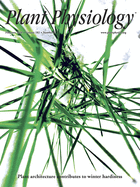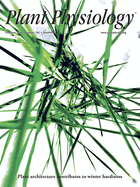
Cover image

During the autumn, the model grass Brachypodium distachyon grows densely and close, unlike its tall form familiar to growers in the summer months. The accumulated branches and leaves of the dense growth may help to insulate its crown tissues and contribute to the over-wintering survival of the plant. Mayer et al. find that this growth transition is influenced by the flowering gene VERNALIZATION1 (VRN1). Image credit: Boris F. Mayer.
Volume 182, Issue 2, February 2020
ON THE INSIDE
On the Inside
NEWS AND VIEWS
The Protein Phosphatase PP2A-B′γ Takes Control over Salicylic Acid to Suppress Defense and Premature Senescence
A Tale of Two Isoforms: Calcium-Dependent Inhibition of SnRK2 by SnRK-Calcium-Binding Sensor
BREAKTHROUGH TECHNOLOGIES
An Online Database for Exploring Over 2,000 Arabidopsis Small RNA Libraries
The Arabidopsis Small RNA Database is a user-friendly, web-based tool for exploring over 2,000 Arabidopsis sRNA-seq libraries.
Rapid Single-Step Affinity Purification of HA-Tagged Plant Mitochondria
Triple hemagglutinin tagging of a mitochondrial outer membrane protein enables single-step affinity purification of intact plant mitochondria in less than 20 minutes.
GRANAR, a Computational Tool to Better Understand the Functional Importance of Monocotyledon Root Anatomy
Generator of Root Anatomy in R (GRANAR) is a new open-source computational tool that can be used to rapidly generate digital versions of monocotyledon root anatomical networks.
RESEARCH REPORT
VENOSA4, a Human dNTPase SAMHD1 Homolog, Contributes to Chloroplast Development and Abiotic Stress Tolerance
Lack of the nuclear protein VENOSA4 (VEN4) affects chloroplast development and acclimation in Arabidopsis, presumably through altered dNTP levels.
RESEARCH ARTICLES
BIOCHEMISTRY AND METABOLISM
Castor Stearoyl-ACP Desaturase Can Synthesize a Vicinal Diol by Dioxygenase Chemistry
The Ricinus communis stearoyl-ACP desaturase is capable of dioxygenase chemistry, converting oleoly-ACP to the natural product erythro-9,10-dihydroxystearoyl-ACP.
Reorganization of Acyl Flux through the Lipid Metabolic Network in Oil-Accumulating Tobacco Leaves
Engineering leaves to accumulate oils induced unexpected changes to fatty acid flux through the leaf lipid metabolic network.
Non-Catalytic Subunits Facilitate Quaternary Organization of Plastidic Acetyl-CoA Carboxylase
Non-catalytic subunits of the heteromeric acetyl-CoA carboxylase facilitate the assembly of an activate enzyme and hence accelerate the ability to generate the key precursor of fatty acid biosynthesis, malonyl-CoA.
Pheophorbide a May Regulate Jasmonate Signaling during Dark-Induced Senescence
Transcriptome and metabolite profiles of key chlorophyll breakdown mutants reveal complex interplay between speed of chlorophyll degradation and jasmonic acid signaling.
NatB-Mediated N-Terminal Acetylation Affects Growth and Biotic Stress Responses
Initiator methionine acetylation by NatB is evolutionary conserved and critical for abiotic stress responses in Arabidopsis thaliana.
Hybrid Cyanobacterial-Tobacco Rubisco Supports Autotrophic Growth and Procarboxysomal Aggregation
Cyanobacterial Rubisco large subunits form functional hybrids with tobacco small subunits and procarboxysome microcompartments via the linker protein CcmM35 in the absence of cognate small subunits.
The Microalga Nannochloropsis during Transition from Quiescence to Autotrophy in Response to Nitrogen Availability
The successful nitrogen availability-mediated transition of Nannochloropsis from quiescence to autotrophy relies on its high flexibility of lipid metabolism, which at least in part involves microlipophagy.
Mutually Regulated AP2/ERF Gene Clusters Modulate Biosynthesis of Specialized Metabolites in Plants
Intra-cluster and mutual regulation of jasmonate-responsive transcription factor gene clusters is evident in the biosynthesis of many plant specialized metabolites.
The Acetate Pathway Supports Flavonoid and Lipid Biosynthesis in Arabidopsis
The Arabidopsis acetate or polyketide pathway operates at the interface of central and lipid metabolism as well as supporting the much better studied phenylpropanoid pathway of flavonoid biosynthesis.
Natural Polymorphisms in Arabidopsis Result in Wide Variation or Loss of the Amylose Component of Starch
Arabidopsis accessions carrying polymorphisms in the GRANULE BOUND STARCH SYNTHASE gene vary widely in the amylose content of leaf starch, and some produce amylose-free starch.
CELL BIOLOGY
Dynamics of Candidatus Liberibacter asiaticus Movement and Sieve-Pore Plugging in Citrus Sink Cells
The phloem-limited Gram-negative bacterium Candidatus Liberibacter asiaticus interacts with the phloem membranes of citrus species and can change its form to move through the phloem pores.
Exogenous Auxin Induces Transverse Microtubule Arrays Through TRANSPORT INHIBITOR RESPONSE1/AUXIN SIGNALING F-BOX Receptors
Exogenous auxin triggers transverse patterning of cortical microtubule arrays through the TIR1/AFB receptor pathway.
GENES, DEVELOPMENT AND EVOLUTION
FLOWERING LOCUS T Improves Cucumber Adaptation to Higher Latitudes
Two large deletions upstream from FLOWERING LOCUS T occurred independently in Eurasian and East-Asian cucumber populations and are associated with higher expression of this gene and earlier flowering.
ErbB-3 BINDING PROTEIN 1 Regulates Translation and Counteracts RETINOBLASTOMA RELATED to Maintain the Root Meristem
ERBB-3 BINDING PROTEIN 1 acts downstream of TARGET OF RAPAMYCIN regulating multiple aspects of protein synthesis in the meristem and counteracts RETINOBLASTOMA RELATED to sustain cell growth.
MADS78 and MADS79 Are Essential Regulators of Early Seed Development in Rice
Misregulation of either MADS78 or MADS79 results in seed abnormalities, due to a mistimed developmental transition of the endosperm and downstream effects on grain quality.
Dark-Induced Senescence Causes Localized Changes in DNA Methylation
Senescence in Arabidopsis causes a massive transcriptional down-regulation of the machinery safeguarding the integrity and maintenance of the chromatin, the senescent methylome however, remains stable.
PERSISTENT TAPETAL CELL2 Is Required for Normal Tapetal Programmed Cell Death and Pollen Wall Patterning
PTC2, an AT-hook DNA binding protein, is required for tapetal programmed cell death and pollen wall patterning in rice.
Shared Genetic Control of Root System Architecture between Zea mays and Sorghum bicolor
Comparisons between root system architecture-associated genes identified from maize and sorghum via GWAS enabled by high-throughput phenotyping reveal conserved functional roles of syntenic orthologs.
MEMBRANES, TRANSPORT AND BIOENERGETICS
Apple ALMT9 Requires a Conserved C-Terminal Domain for Malate Transport Underlying Fruit Acidity
An apple malate transporter lacking a conserved C-terminal domain causes low fruit acidity.
SIGNALLING AND RESPONSE
Two Chloroplast Proteins Negatively Regulate Plant Drought Resistance Through Separate Pathways
The chloroplast proteins depress H2O2 accumulation in guard cells and drought resistance through OST1-dependent and OST1-independent pathways.
Treatment Analogous to Seasonal Change Demonstrates the Integration of Cold Responses in Brachypodium distachyon
Reproducing seasonal change in laboratory settings uncovers integration and contribution of vernalization, cold acclimation, and plant morphology to cold adaptation in the model grass B. distachyon.
Switching the Direction of Stem Gravitropism by Altering Two Amino Acids in AtLAZY1
A structure-function analysis identifies a conserved domain of the Arabidopsis LAZY1 protein that reverses the direction of stem gravitropism by switching the causal auxin gradient.
CATION-CHLORIDE CO-TRANSPORTER 1 (CCC1) Mediates Plant Resistance against Pseudomonas syringae
Arabidopsis CCC1 functions in strengthening plant structural and chemical barriers and mediates plant resistance against Pseudomonas syringae.
Brassinosteroids Antagonize Jasmonate-Activated Plant Defense Responses through BRI1-EMS-SUPPRESSOR1 (BES1)
A key transcription factor antagonizes JA-activated plant defense responses by suppressing the expression of defensin and glucosinolate biosynthesis genes.
The FATTY ACID DESATURASE2 Family in Tomato Contributes to Primary Metabolism and Stress Responses
A gene family that is required for synthesis of polyunsaturated fatty acids also contributes to aphid resistance in tomato.
A Role for Plant KASH Proteins in Regulating Stomatal Dynamics
Protein complexes at the nuclear envelope—known to connect the nucleus to the cytoskeleton—affect stomatal opening and closing in response to a variety of signals.
Regulation of Sugar and Storage Oil Metabolism by Phytochrome during De-etiolation
Phytochromes activate sugar and storage oil metabolism to support the transition from heterotrophic to photoautotrophic growth and chloroplast development during de-etiolation.
Compensatory Mutations in GI and ZTL May Modulate Temperature Compensation in the Circadian Clock
The physical interaction between naturally occurring mutant variants of Arabidopsis circadian clock components contributes to temperature compensation in the Cape Verde Islands.
Two SnRK2-Interacting Calcium Sensor Isoforms Negatively Regulate SnRK2 Activity by Different Mechanisms
Two isoforms of SnRK2-interacting calcium sensor are expressed in Arabidopsis;they differ in calcium binding properties, but both inhibit SnRK2s and subsequently fine tune abscisic acid signaling.
PROTEIN PHOSPHATASE 2A-B′γ Controls Botrytis cinerea Resistance and Developmental Leaf Senescence
PP2A-B′γ interacts with CALCIUM-DEPENDENT PROTEIN KINASE1 and age-dependently controls salicylic acid-related signaling in plant immunity and developmental leaf senescence.


